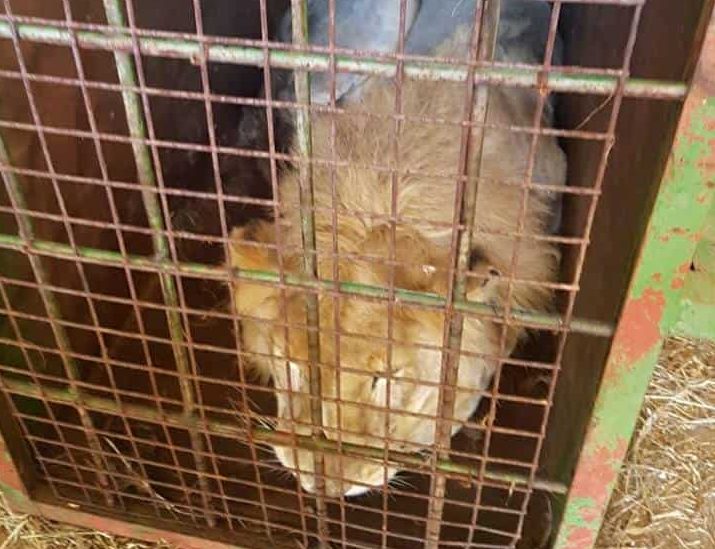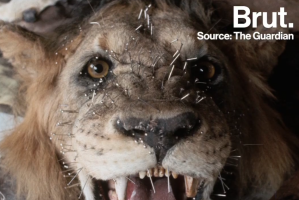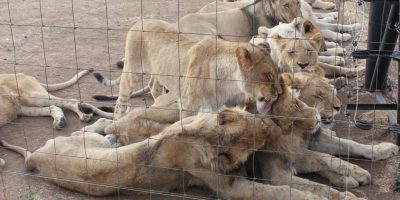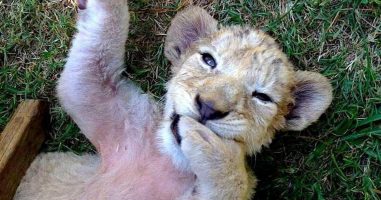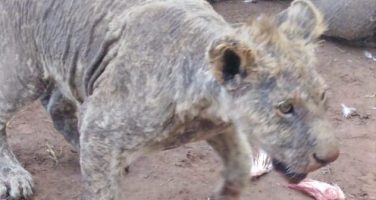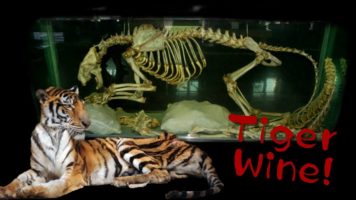The Ongoing Disgrace of South Africa’s Captive Lions
An estimated 7,000 to 14,000 (numbers vary) captive lions are held at over 300 Lion breeding facilities in South Africa. Increasingly, the animals are slaughtered for their bones and other body parts, many of which are sold in Asia for their purported — and scientifically discredited — health benefits.
Original article by September 18, 2018 Yale Environment 360 Shortened for better readability
The incident at the Lion Slaughterhouse in Bloemfontein, Free State
Reinet Meyer is the senior inspector at the SPCA in the provincial city of Bloemfontein. She had received a tip. Two adult captive lions had been held 2 days without food or water in tiny transport crates on a farm called Wag ‘n Bietjie. She went to the farm, found the lions, and discovered they’d been trucked about 250 miles. They came from Predators Pride, a “safari park” near Johannesburg. It keeps big cats in small enclosures so tourists can get close to them. For an extra fee, hold lion cubs or cuddle adult cheetahs while having their photos taken.
She then noticed a large pile of rotting, fly-covered meat outside a farm shed. Inside she found a supervisor. About eight workers stripped the skin and flesh from the fresh carcasses of 26 lions. “You could see that it wasn’t the first time they’d done this,” she says. That afternoon a truck arrived with 28 additional lions, which were to be killed the next day. Meyer insisted that the lions be released into a corral rather than be left in their transport crates overnight.
She returned to Wag ‘n Bietjie the next morning to observe that animal welfare standards were being maintained. A veterinarian arrived at 9 a.m., drove into the newly arrived lions’ corral in a pickup truck, and darted all 28 with tranquillizers. As they lapsed into unconsciousness, he walked from one to the next. He methodically shot each in the ear with a .22-caliber rifle. “Overseas buyers don’t want a skull with a bullet in it,” he told Reinet. Which is why he didn’t shoot them directly in the cranium.

Jabula the Lion killed at Lion Slaughterhouse near Bloemfontein © Conservation Action Tiger Bone products made from Captive Lions
These lion carcasses, as well as the ones Reinet had seen the previous day, were being processed into skeletons to be sold to wildlife product dealers in Asia. They would likely resell them as “tiger bone” to be made into a wide variety of products. Products like jewellery, “tiger-bone wine or -cake”, and a dizzying array of “health tonics.” There is no mainstream scientific proof that tiger bone is of genuine medical use. On further investigation, Meyer counted 246 lions confined elsewhere on the farm, more than 100 of which were scheduled to be shot and reduced to bones.
As grotesque as the scene at Wag ‘n Bietjie was, the farmer gave Meyer unfettered access to his property. Although he expressed unease at killing the animals, he told Meyer that he was making good money. It was all legal; he had government permits to keep and kill lions.
The low-tech lion slaughterhouse that Meyer had stumbled upon was part of South Africa’s large and increasingly controversial captive-bred lion industry. Not even Edna Molewa’s DEA knows how many lions this industry currently holds because it is poorly monitored. But, it’s one of the most lucrative of South Africa’s wildlife breeding sectors. It
has generatedgenerates tens of millions of dollars annually from a worldwide client base.Captive Lions History – Part I
The industry originated in the
late1990s* to provide relatively cheap lions for foreign trophy hunters to shoot in fenced areas. (*More than 20 years ago, in 1997, the findings of The Cook Report investigation were presented to the public by the famous Roger Cook). Captive Lions (Males) were sold between $25,000 and $40,000. Females sold at half of it. But following U.S. restrictions on trophy imports from such “canned” hunts, the captive-bred lion industry is increasingly focused on supplying bones to Asia.Supporters of the industry, especially the late Edna Molewa, the South African Environment Minister, promote captive lion breeding. They define slaughter as an example of “sustainable utilization of natural resources”. But increasingly vocal opponents, including prominent hunters, say that it is cruel and damaging to South Africa’s reputation. There is no benefit to wildlife conservation. Luke Hunter of the leading big cat conservation group Panthera says captive-bred lions have “unequivocally zero” conservation value.
The debate about the industry is heating up — hunting groups have split over it. Lobbyists on both sides are ramping up their rhetoric. Now politicians are considering legislating against it. Because lions are a high-profile species and the captive-bred lion industry sells its products globally, South Africa’s decisions will have ripple effects through the international hunting and wildlife trades.

Roger Cook, who first uncovered the Canned Hunting Industry © LionAid The circuit of abuse and exploitation
Wild female lions only give birth every 18 months to two years, but in captivity, cubs
can beare removed within days of being born. This allows the females to produce up to four litters every two years. Lion breeders have learned to profit from every stage of a lion’s life.First – they extract by extracting cash and free labour from “voluntourists”. These are often young foreigners in their school gap year and who pay well for the chance to hand-raise cubs while being told that “their” lions will later be released into the wild.
Then – breeders charge tourists to hold cubs for photos, and when these cubs become adolescents, charge tourists again to go on “walking with lions” excursions.
Then – adolescent lions become too large to be controlled — hand-raised lions have no fear of humans and can be extremely dangerous — they are sold to trophy hunting outfitters,
Later – they are released into fenced areas, and lion farms guarantee their clients easy, time-efficient kills, often without disclosing that the lions being shot are effectively tame.
With its increasing size and high profile, the industry inevitably attracted scrutiny. In late 2016, the U.S. Fish and Wildlife Service banned the import of captive-bred lion trophies, saying the industry had not proved that it benefited the long-term survival of lions in the wild. (Trophies from wild lion hunts could still be imported, however, because the agency found that trophy fees often went toward habitat conservation and anti-poaching patrols).
Almost overnight, the industry lost more than half its hunting clients. Prices of Captive Lions plummeted. But the game wasn’t over for lion breeders. They had an alternative market for their products — the bone trade — which they had quietly been developing since 2008.
Captive Lions History – Part II
A trophy hunter normally takes just the skull and skin of the lion to a taxidermist to be mounted. The flesh and remainder of the skeleton remain with the outfitter or landowner. Before 2008, this was normally disposed of. In 2008, however, the first exports of lion bones — 35 skeletons — from South Africa to Southeast Asia took place. Arranged by powerful Asian syndicates that finance and commit wildlife crime in dozens of countries.
The business grew rapidly. In 2009 and 2010, for example, 16 consignments totalling 320 lion skeletons were exported to Laos. Nine of these consignments were destined for Vixay Keosavang, a circuit of abuse and exploitation that deals in a wide range of threatened species. (In 2013, the U.S. government led to the dismantling of his organization, the Xaysavang Network.) Early South African lion bone exporters included Marnus Steyl, a game rancher who has been implicated in “The circuit of abuse and exploitation“.
By 2015, exports had risen to around 1,300 skeletons per year. Between 2008 and 2016, South Africa exported a total weight of more than 70 tons of bones, and almost all Southeast Asian countries were known as hubs of the illegal wildlife trade. That robust business continues today.
Wildlife crime researchers say that Asian wildlife syndicates view lion bone as a convenient substitute for tiger bone. There are well-established markets — albeit often black markets — across Asia. Tigers have long been listed in Appendix 1 of the Convention on International Trade in Endangered Species (CITES) treaty. This mean means that virtually all international trade in their parts is banned.
How Lion Bones become Tiger Bones
African lions have long been viewed as less threatened than tigers and have been listed in Appendix 2. As a matter of fact, this allows international trade subject to permits. Lion bones leave South Africa legally, with CITES permits. Once it arrives in Southeast Asia, it is typically relabeled as tiger bone and smuggled to black markets. Thus, the legal product feeds illegal businesses. (Anti-hunting activist groups have recently identified numerous criminal participants in the South Africa-to-Southeast Asia lion bone trade.)
In Vietnam, lion bones are likely made into “tiger-bone cake,” an expensive “traditional remedy” with no proven medicinal properties. It is made by boiling bones along with turtle shells and other ingredients until they disintegrate. Then it is compacted into a chocolate bar-like “cake”. In China, the skeletons of big cats are often suspended in large vats of alcohol, which are tapped to produce “tiger-bone wine.”

